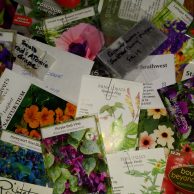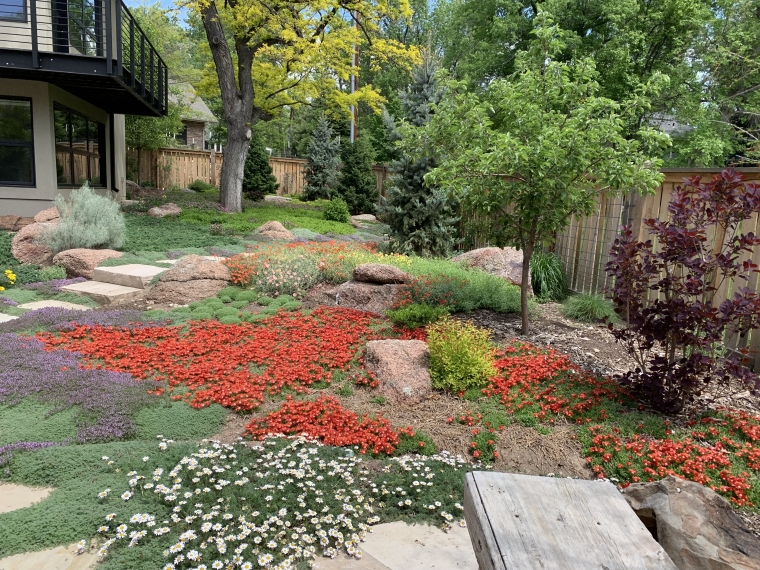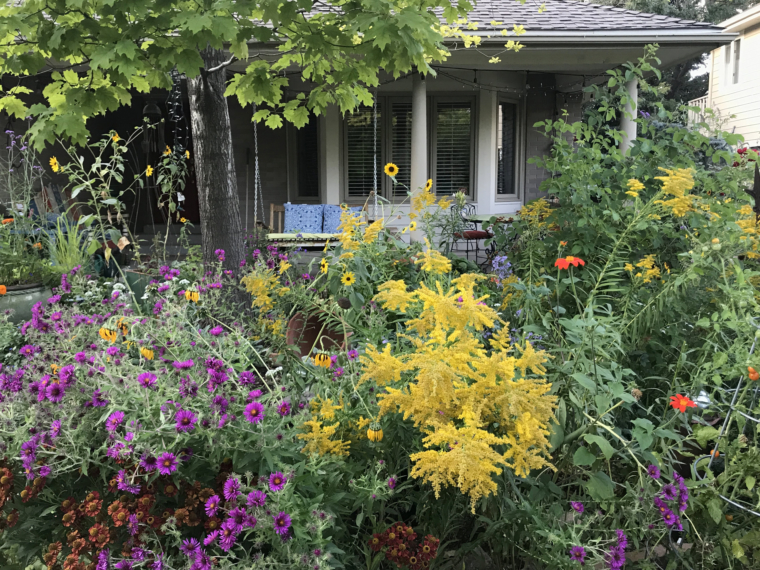Mineral-rich fertilizer containing trace minerals in a form that is readily available to plants at any soil pH. Feeds plants and soil life.
Myke Mycorrhizae
 Myke has two different blends of mycorrhizae to help when transplanting. One for vegetable gardens in the green bag and one for tress and shrubs in the blue box. Both stimulate root development and phosphorous uptake while reducing watering needs.
Myke has two different blends of mycorrhizae to help when transplanting. One for vegetable gardens in the green bag and one for tress and shrubs in the blue box. Both stimulate root development and phosphorous uptake while reducing watering needs.
Neptune’s Harvest Organic Fertilizers
We like these fertilizers derived from the mineral rich North Atlantic Ocean and carry several of their different dry and liquid fertilizers. [Read More]
Planters II
Rock dust fertilizer containing over 30 trace minerals. Great for clay, rock gardens, natives, cacti, and vegetables. Especially good for penstemons & wildflowers. Best for soil prep or side-dress every 2 years.
Rich Lawn
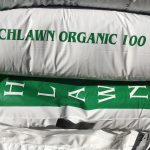 a 100% organic product made in Platteville from dehydrated poultry manure and beetle-kill wood wastes. Excellent for shrubs and trees and is recommended for raspberries and other small fruits. Economical and is effective for fertilizing lawns. Listed by OMRI for organic use. Ideal for lawns, trees, shrubs, annuals, perennials, vegetables and roses. Covers 2,000 sq. ft. for turf. 5-3-2.
a 100% organic product made in Platteville from dehydrated poultry manure and beetle-kill wood wastes. Excellent for shrubs and trees and is recommended for raspberries and other small fruits. Economical and is effective for fertilizing lawns. Listed by OMRI for organic use. Ideal for lawns, trees, shrubs, annuals, perennials, vegetables and roses. Covers 2,000 sq. ft. for turf. 5-3-2.
Rock Phosphate
a natural source of phosphorus and calcium, immediately available over a long time. Does not reduce mycorrhizae like petroleum-derived phosphorus.
Rocky Mountain Minerals
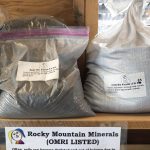 This is a rock dust product containing over 30 trace minerals. When there is not a proper balance of trace minerals, deficiencies will cause problems with plant growth. In heavy clay soils, movement of these minerals is difficult. Therefore it is good to add Planters II when doing your soil prep. It can also be broadcast around established plants every two years. Very beneficial for vegetables, native plants, cacti and succulents and for supporting a healthy soil life.
This is a rock dust product containing over 30 trace minerals. When there is not a proper balance of trace minerals, deficiencies will cause problems with plant growth. In heavy clay soils, movement of these minerals is difficult. Therefore it is good to add Planters II when doing your soil prep. It can also be broadcast around established plants every two years. Very beneficial for vegetables, native plants, cacti and succulents and for supporting a healthy soil life.
Seed Dreaming
By Eve Reshetnik Brawner
“Every day, millions upon millions of seeds lift their two green wings” (Janisse Ray)
(Okay, if it’s a ‘monocot’, it only lifts one green wing, but we can allow a bit of poetic license)
I love seeds. They’ve fascinated me since early childhood. Some of my earliest memories involve examining maple samaras, sycamore balls, acorns and pine cones, and planting peas and Sweet Alyssum and lima beans in cut-off milk cartons on the kitchen windowsill. I am still in awe of the power packed into a seed. [Read More]
Xeriscape: Native Plants
Achillea lanulosa (Achillea millefolium var. lanulosa) (Yarrow)
Agave parryi neomexicana
Amelanchier alnifolia (Serviceberry)
Amorpha canescens (Leadplant)
Aquilegia barnebyi
Aquilegia caerulea (Rocky Mt. Columbine)[Read More]
2019 Tomato Tasting Results
This year’s tomato tasting was a great success, with a total of 41 tomato varieties present over the 3-hour event!
Participants brought in some wonderful new varieties this year, including Pink Bumble Bee Cherry, Gajo de Melon, and Blue Cream Berries. We always take people’s votes into account when deciding which tomato varieties to carry, so look for the most popular varieties from this year and previous years when you come to buy your organic tomato starts next spring at Harlequin’s Gardens. Every year we grow 80+ great varieties for all kinds of uses and growing conditions! A huge thank-you to Growing Gardens for providing our the location, helping us publicize the event, and for bringing us some fabulous volunteers. Thank you also to the volunteers of Slow Food Boulder County. We couldn’t have done it without you!

2019 Taste of Tomato Vote Tally
Virtual Garden Tour – Tracy I.
1.What percentage of the plants in the pictures do you think came from Harlequin’s Gardens?
most.
- Did you create this garden (you and your family) or did you have professional help? Describe briefly
We had a landscaping company do the hard-scape for which they did a fantastic Job. Then had them and a nursery plant most of large trees, shrubs and some perennials. I did most of the ground covers.
- What is the age of this garden? What town or area? What elevation?
This garden is 3 years old.
It located in north Boulder.
it’s about 5,500 ft.
- What irrigation method(s) do you use and how often do you water and for how long?
We have under ground soaker system. We water trees once a week for 1.5 hours. Perennials 30min. 3 times a week.
- What is your soil like? Did you amend it? With what?
It was sterile top soil the landscaper bought in. I added many truck loads of compost from a local company over 2 falls and 2 springs.
- How big is your garden and how often do you work in your garden?
This garden is about 4000 sq. ft. I worked a lot the first 2 years because the garden was new. I did the soil amendment, planting, weeding….etc. But, this year I only worked a few hours a week, There isn’t much weeding, But, there is a bit of deadheading.
- What has, or currently does, inspire you to garden and use sustainable practices?
I love nature! Plants, animals…all things of nature.
- How do you deal with “weeds”? What is your approach to insect pests and disease?
I hand pick weeds.
This year I had a Japanese beetles problem. I hand picked them everyday.
- Share a brief story about something you learned from your garden or plants, or inspiration received from gardening?
For the first 2 years I didn’t really pay much attention to or enjoy the beauty of the garden. It caused me a lot of stress because I didn’t hire perfessional gardeners and I didn’t know much about plants or planting. At that time I just want to finish the project. However this spring (June,2019), my husband and I were so surprised to see our beautiful garden after being away for 2 months.
Now, walking around my garden everyday is happiness for me.
- What is your experience growing plants from Harlequin’s Gardens.
I find their plants to be healthy, unique and hardy.
- Is there anything else you’d like to share with us and/or our community?
If you enjoy animals, plant a lot of flowering plants and humming bird mints.
Happy gardening!Tracy
Fruit Available 2021
APPLE
- Freedom
- Haralred
- Haralson
- Hazen
- Honey Gold
- Liberty
- Norland
- Rhuby
- Snow Sweet
- Sweet Sixteen
- Zestar
- Dolgo (edible crab apple)
APRICOT
- Debbie’s Gold
- Pioneer
CHERRY (shrub)
- Crimson Passion
- Orient
CHERRY (tree)
- Juliet
- Montmorency
- North Star
- Romeo
CHOKECHERRY
- A. melanocarpa – ‘Iroquois Beuaty’
CURRANTS
- Alagan (R. nigrum)
- Blanca (R. sativum)
- Clove Currant (R. odoratum)
- Crandall (R. odoratum)
- Golden Currant (R. aureum)
- Gwen’s Buffalo (R. aureum)
- Red Lake (R. sativum)
- Titania
ELDERBERRY
- S. canadensis ‘Adam’s’
- S. canadensis ‘Nova’
- S. canadensis ‘York’
- S. canadensis ‘John’s’
- S. nigra ‘Madonna’
- S. nigra ‘Marge’
- S. nigra ‘Mikl’s’
- S. nigra ‘Samdal’
- S. nigra ‘Scott’
- S. nigra ‘Thundercloud’
GOJI BERRY
- Phoenix Tears
GOOSEBERRY
- Captivator
- Hinnomaki Red
- Invicta
- Jostaberry
- Orus#8
- Red Jacket (Comanche)
- Tastiberry
MULBERRY
- M. alba ‘Morden’
- M. alba ‘Tatarica’
PEACH
- Peach – ‘Reliance’
PEARS
- Ayers
- Loma
- Nova
- Parker
- Patten
- Southworth
- Summer Crisp (Asian)
PLUM
- Alderman
- Damson
- La Crescent
- Mount Royal
- Northern Blue
- Stanley
- Superior
- Toka
- Vermont
SERVICEBERRY
- Autumn Brilliance
- Princess Diana
- Prince William
- Regent
STRAWBERRY
- Alexandria’s
- Earliglow
- Eversweet
- Ogallala
- Ozark Beauty
- Quinalt
- Wild (Fragaria virginiana)
Fruit Varieties Available in June/July 2021
APPLE
- Cortland
- Fameuse
- Honeycrisp
- Red Baron
BLACKBERRY
- Triple Crown (Thornless)
CURRANTS
- Black Velvet (Gooseberry)
- Champagne Pink
- Hinnomaki (Gooseberry)
- Imperial White
- Rovada Red
- Triple Crown
ELDERBERRY
- Adam’s (S. canadensis)
- John’s (S. canadensis)
- Cheyenne (S. nigra)
- Laciniata (S. nigra)
- Mikl’s (S. nigra)
GRAPE
- Concord
- Concord Seedless
- St. Croix
- Swenson’s Red
HOPS
- Cascade
- Willamette
PEACH
- Contender
- Red Haven
PEAR
- Frederika
- Hudar
- Loving
- Manning-Miller
- Savignac
- Tyson
PLUM
- Green Gage
- Yellow egg
- Italian
RASPBERRY
- Royalty Purple
- Caroline Red
- Heritage Red
- Anne Yellow
- Polana
OTHER
- Asparagus – Jersey Knight
- Asparagus – Purple Passion
- Goji Berry (Phoenix Tears)
- Horseradish
- Hazelbert
- Rhubarb – Crimson Red
- Strawberry – ‘Earliglow’
Herbs We Carry
- Anise Hyssop
- Arnica
- Basil
- Cinnamon
- Nufar Genovese
- Italiano Classico
- Finissimo Verde a Palla
- Holy Basil-Tulsi
- Mrs. Burns Lemon Basil
- Thai
- Sweet
- Borage
- Calendula
- Catnip
- Celery, Cutting
- Chamomile, Roman
- Chervil
- Chives
- Cilantro
- Clary Sage
- Comfrey
- Dill
- Fennel
- Bronze
- Green
- Feverfew
- Garlic Chives
- Heart’s Ease / Johnny Jump-ups
- Hops
- Hyssop
- Ladies Mantle
- Lamb’s Ears
- Lavender
- Provence
- Grosso
- Hidcote
- Munstead
- Dwarf
- Krajova
- Twickle
- Lemon Balm
- Lemon Grass
- Lemon Verbena
- Lovage
- Marjoram, Sweet
- Marshmallow
- Meadowsweet
- Mint
- Chocolate Peppermint
- Kentucky Peppermint
- Spearmint
- Motherwort
- Mugwort
- Nasturtium
- Nepitella
- Oregano
- Dwf. Greek
- Greek
- Norton’s Gold
- Parsley
- Pennyroyal
- Pyrethrum
- Red Clover
- Rosemary
- Arp
- Madeline Hill
- Irene
- Tuscan Blue
- Gorizia
- Rue
Sage (culinary)- Berggarten
- Tricolor
- Golden Variegated
- Purple
- Santolina
- Gray
- Green
- Self-Heal
- Skullcap
- Stevia
- Stinging Nettles
- Summer Savory
- Sweet Woodruff
- Tarragon, French
- Thyme
- French
- Caraway
- Lemon
- Silver
- Valerian
- Vietnamese Coriander
- Viola
- Corsican
- Arkwright Ruby
- Etain
- tricolor
- Winter Savory
Join Our Virtual Garden Tour!

For over a quarter century Harlequin’s Gardens has shared plants, Eco-products, and advice for organic methods of gardening with our community. We are proud of the success so many have had and want to create a forum for all to share their results.
So, we’re creating a “Virtual Garden Tour” for our community to share not just photos of their gardens but also a little about gardening goals, styles and experiences–especially sustainable approaches.[Read More]
Xersicape: Non-Native Plants
Acantholimon glumaceum
Acantholimon hohenackeri
Acantholimon litwanovii
Achillea ‘Moonshine’
Achillea ageratifolia (Greek Yarrow)[Read More]
Narcissus ‘Tete a Tete’
 One of the best heirloom award-winning Cyclamineus daffodils, we have grown this miniature variety in our Xeriscape Rock Garden for many years. The graceful, floriferous early-bloomer has a reflexed, buttercup-yellow perianth surrounding a trumpet-like, darker yellow cup. For naturalizing, rock gardens, border plantings, and forcing. Hardy to Zone 4, 6” – 7” tall, Deer and rodent-proof! Plant 6” deep, 3-6″ apart.
One of the best heirloom award-winning Cyclamineus daffodils, we have grown this miniature variety in our Xeriscape Rock Garden for many years. The graceful, floriferous early-bloomer has a reflexed, buttercup-yellow perianth surrounding a trumpet-like, darker yellow cup. For naturalizing, rock gardens, border plantings, and forcing. Hardy to Zone 4, 6” – 7” tall, Deer and rodent-proof! Plant 6” deep, 3-6″ apart.
Virtual Garden Tour – Deb K.
(1) What percentage of the plants in the pictures do you think came from Harlequin’s Gardens? (Mandatory Question)
Most!
(2) Did you create this garden (you and your family) or did you have professional help? Describe briefly
I had help 7 years ago removing my grass (from a laborer who was doing demolition on my kitchen). I hired Laura R. Laura is a trained permaculturalist and she helped with garden design, with the limited hardscape and with sheet mulching to build soil. I now employ the women of Suncat Gardening for their help doing seasonal pruning and garden clean-ups. The garden has evolved over the years.
(3) What is the age of this garden? What town or area? What elevation?
My garden is in N. Boulder, elevation 4,859 ft.
The garden was begun in the summer of 2011 with the grass removal, was sheet mulched in November 2011 and was initially planted in spring 2012. It’s 7.5 years old.
(4) What irrigation method(s) do you use and how often do you water and for how long?
We do a combination of watering. We have drip and low flow sprinklers for some areas, we hand water vegetables in season and have been lucky this year to have had Mother Nature’s help in irrigating.
(5) What is your soil like? Did you amend it? With what?
My soil has been built over time from sheet mulching. Every autumn it gets top dressed with leaves and compost and it’s amended annually with manure, compost and fed with Harlequin’s fertility mix.
(6) How big is your garden and how often do you work in your garden?
I have a relatively small garden that is filled to bursting with perennials and a few edibles (an Italian prune plum, herbs, blackberry vines and greens) . My front yard spaces are no more than 300 sq. feet combined. I have an additional 300 sq. feet or so in the backyard. During the spring and summer I spend at least 2-4 hours in the garden weekly. The fun thing about my jungle like yard is that I can neglect it for a couple weeks and no harm is done. I love to meander and pick bouquets of flowers. The more flowers I pick the more blooms I get.
(7) What is your general approach to gardening? What has, or currently, inspires you to garden and use sustainable practices?
I garden for so many reasons. My garden is my refuge when I need to think and recharge and it’s also my classroom. I see my own health and well being reflected in my garden and for this reason I will only use organic, nature derived pest control remedies and fertilizers. As I have tried to create healthy gut microflora for my body so do I work with the application of compost, compost tea and mycorrhizae to build microorganisms in my soil.
(8) How do you deal with “weeds”? What is your approach to insect pests and disease?
I hand pull weeds and have tried various compost tea approaches to change the soil nutrition to discourage various weeds. I’ve also found that my dense planting and healthy “desired plants” choke out unwanted plants. Insect pests are discouraged through planting and fertilizing strategies (for instance, using solar caps to put out my tomato starts in early April allowed my plants to become healthy and robust before the immersion of flea beetles). I’ve also employed diatomaceous earth, hand picking off pests and various soap sprays. Mulching my roses routinely with shredded banana peels and planting companion plants to encourage predatory beneficial insects has almost completely eliminated aphids. My ladybug friends are numerous and helpful.
(9) Share a brief story about something you learned from your garden or plants, or inspiration received from gardening?.
I feel that magic happens daily in my flower garden. Last summer I came home from a long day to discover a couple of hand painted rocks had been left in my path that read “spread joy” and “be kind”, gifts from the, now nearly teenage children, who grew up bringing their friends to tour the gardens and search for fairies. My favorite 5 year old regularly visits, hands on his hips, with the strong request “what can I eat?!”. He loves fresh garden peas and nasturtiums and blackberries that he often grabs while they’re still unripe and declares “look, a raspberry!” but is equally content with fistfuls of kale that he grabs for the long journey home (just across the street).
(10) What is your experience growing plants from Harlequin’s Gardens.
Harlequin’s plants are locally grown, healthy without the application of neonitotinoids, well adapted to our climate and overwhelmingly successful. I find shopping at Harlequin’s to be addictive; I’m forever discovering new specimens that I MUST have and my garden is proof of the adage that you can never have too many plants!
Growing Fragrant Paperwhite Narcissus
 Potted Paperwhites bring intoxicating fragrance to your home in winter, and make wonderful holiday gifts. They bear trusses of heavily-scented, pure white flowers on up to three stems per bulb. They may be planted in all kinds of decorative pots, vases and trays, either in soil or pebbles, from now through February. [Read More]
Potted Paperwhites bring intoxicating fragrance to your home in winter, and make wonderful holiday gifts. They bear trusses of heavily-scented, pure white flowers on up to three stems per bulb. They may be planted in all kinds of decorative pots, vases and trays, either in soil or pebbles, from now through February. [Read More]
Nectaroscordum bulgaricum (Sicilian Honey Lilly)
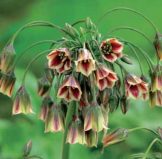
Sicilian Honey Garlic or Mediterranean Bells
Bulb. Z3. 30-36” tall. Blooms late spring / early summer. Compost-improved soil.
Unusual, stunning bell flowers are highly attractive to native and European honey bees. One of my favorite bulbs in the garden! It is grown both as a long-blooming ornamental and as a culinary herb throughout the Mediterranean. Fragrant blooms. Naturalizes easily. Grows well in containers. Very hardy. Adds interest to cut flower arrangements. Great in rock gardens and containers. Deer and rabbit resistant. Gorgeous paired with lupine, columbine, tall verbena, and lady’s mantle.
Non-Toxic Weed and Pest Control
 Non-toxic Herbicides
Non-toxic Herbicides
Summer is a successful time to kill weeds, either by mechanical weeding or with herbicides. But toxic herbicides, like Roundup are not solutions we recommend. Roundup in particular was once believed to be quite safe, but now is shown to be harmful to soil life including nitrogen-fixing bacteria, amphibians and is a probable human carcinogen. Roundup formulations can be up to 400 times more toxic than the active ingredient, glyphosate.
At Harlequin’s Gardens, we only sell non-toxic products, but not all non-toxic products are actually effective. Four years ago we tested five non-toxic herbicides and found only two to be really effective: 20% Vinegar and Avenger.
20% Vinegar is 20% acetic acid. It is a non-selective organic acid that quickly kills many weeds, then quickly biodegrades. Repeated use can acidify the soil which is usually a benefit in our alkaline soil. Be careful not to spray desirable plants, and be careful to protect your eyes, especially on windy days. It is most effective on small plants. Repeated applications may be necessary on perennial weeds.
Avenger is a citrus oil weed killer that we found to be equally effective as the vinegar. It is certified organic and is biodegradable. Avenger is non-selective so care must be taken to keep spray off desirable plants. It comes in a ready-to-use (RTU) formula and in a concentrate which may be mixed stronger for tougher, perennial weeds. Like vinegar, it is most effective on small plants, and is best sprayed during hot weather in direct sunlight.
In order to “control” bindweed and other weeds with extensive root systems, don’t let new growth get longer than 2″ or the weed will revive.
BLISTER BEETLE: We have been hearing reports of Blister Beetle attacking clematis. This is a light grey, long beetle that can defoliate a clematis vine in 2 or 3 days. We have found that an organic product called Veggie Pharm actually kills this beetle. It must be sprayed directly on the beetle. (Don’t try to pick up a Blister Beetle; they can raise a blister)
Tree Wrap: We recently saw a big buck with his antlers in the velvet stage. This the time of year deer cause the most damage, when bucks rub their itchy antlers on smooth, usually young tree trunk, tearing the bark. Sometimes a young tree can be girdled in one night. We carry a very good spiral plastic tree wrap that protects trees from deer, rabbits, sun scald in winter. It is superior to paper wraps because it lets air circulate so moisture does not decay the bark. It can be left on in the summer and it expands as the tree grows. Once the bark is older and tougher, it will no longer need protection.
Harvest Guidelines for Summer Crops
Here are a few harvest guidelines for summer crops:
Eggplants should be picked while they are still firm and glossy. Once their skins have become dull, they will be softer and have dark seeds, which can spoil the flavor. Eggplants don’t keep long, so use them soon after harvest.
Bell peppers and sweet frying peppers are sweetest when allowed to ripen fully to their mature color, yellow, orange, red, purple or mahogany. Bell peppers are often picked green, but their flavor will be a lot more pungent and they may be more challenging to digest.
Some of the hot peppers are traditionally enjoyed green – poblano, mulatto, jalapeno, Anaheim-type, while most of the rest are allowed to ripen to red (cherry, habanero, cayenne, lanterna, any chile dried for a ristra, etc.) orange (Bulgarian Carrot), or dark brown (Pasilla).[Read More]
Tulip ‘’Blushing Apeldoorn’
Tulip ‘Blushing Apeldoorn’
Bulb. Z3. 18-20” tall. Blooms mid-spring. Compost-improved soil.
This Darwin hybrid has rich yellow petals with soft red edging and a splash of tangerine. Has extra large flowers. Makes for a stunning display. Sturdy stems withstand spring snows and winds. Excellent cut flower. Stunning when combined with single-hued yellow and red tulips or other flowers such as basket-of-gold that also bloom in mid-spring.
Tulip ‘Lasting Love’
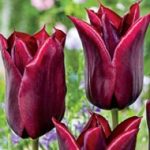
Tulip ‘Lasting Love’
Extend the tulip season with this elegant beauty. Lasting Love’s dramatic deep burgundy petals are edged with softer red tones. The slightly recurved petals give it a very sophisticated look. Blooming in late spring (May) atop 18-20″ sturdy stems, it’s a beautiful cut-flower, too. The foliage on this variety is also notable, in an attractive blue-green hue. Lasting Love is a perennial tulip that returns year after year. Tulips perform best when planted in well-drained soil and in full sun to partial shade. Hardy in Zones 3-8.
Garlic – Spanish Roja (hard-neck)
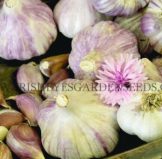
Photo Credit, Irish Eyes Garden Seed
This vigorous, easy-to-grow heirloom variety arrived in the US over 100 years ago. It is famous for its classic rich, complex ‘true garlic’ flavor and is one of the most popular with restaurants/chefs. The large, purple streaked bulbs often reach three inches in diameter and typically have seven to twelve large tan cloves. Spanish Roja peels easily and keeps for up to 4-6 months when properly stored (the outer bulb wrappers are thin and flake off easily so be careful to keep them intact to prolong storage). Like all hard-neck garlic, Spanish Roja will produce curly ‘scapes’ (flowering stems), which can be snipped off and used for another culinary treat in late spring. This variety grows well in cold winter areas, and is cold-hardy to Zone 3.
Tulipa kaufmanniana ‘The First’ (Waterlily Tulip)
 A gorgeous, sturdy, low-growing (8”) naturalizing tulip, perfect for the rock garden, meadow or perennial border. ‘The First’ is very early, blooming in March or April. When closed, the red and white outer petals present a candy-cane striped effect. On sunny days, they open wide (~4″) and look like single waterlilies, revealing an ivory white interior with a bright yellow center and, sometimes, small coral-red markings.
A gorgeous, sturdy, low-growing (8”) naturalizing tulip, perfect for the rock garden, meadow or perennial border. ‘The First’ is very early, blooming in March or April. When closed, the red and white outer petals present a candy-cane striped effect. On sunny days, they open wide (~4″) and look like single waterlilies, revealing an ivory white interior with a bright yellow center and, sometimes, small coral-red markings.
Hardy to Zone 3. Plant 6” deep, 6” apart. Zone 3, 4” tall.
Tulipa ‘Paul Scherer’ Triumph Midseason Tulip – NEW AGAIN!
 NEW for 2019!
NEW for 2019!
The darkest Triumph tulip, dramatic purple-black with a straight-sided shape. Earlier than ‘Queen of Night’ but a very similar color. Contrasts wonderfully with any color of tulip, whether your garden plan is classic or goth. Triumph tulips perennialize well in the garden if left uncut and fertilized after blooming. 16–18″ tall. Mid Spring blooms, Z3-7
Amaryllis ‘Minerva’
 The full petals of this bright and stylish Amaryllis are a saturated red, overlaid with a white star and accented by stippled veining and a light green throat.
The full petals of this bright and stylish Amaryllis are a saturated red, overlaid with a white star and accented by stippled veining and a light green throat.
Available in our decorative gold-boxed holiday sets, which include the bulb, a white plastic growing pot, soil disc, and planting instructions.
Amaryllis ‘Red Lion’
 A gorgeous, bright red flower with wide petals. A perfect holiday decoration!
A gorgeous, bright red flower with wide petals. A perfect holiday decoration!
Available as individual bulbs, and in our decorative gold-boxed holiday sets, which include the bulb, a white plastic growing pot, soil disc, and planting instructions.
Pea-Planting Advice
Local advice from our friend Elizabeth:
Hi All, I have been trying a new technique (at least for me) of starting peas in sections of guttering (which I got at Resource) in the greenhouse, growing them on until they are about 4 inches tall, and then transferring them to a trench in the garden. So far it seems to be working fairly well. The peas germinate really fast and grow quickly in the greenhouse. You could probably do it in a house too. I plug up the ends of the guttering with a piece of foam and duct tape. When I am ready to transfer them, I dig a trench, remove the foam and duct tape, spread the sides of the guttering away from the soil, and slide them out of the guttering into the trench. The sliding is the tricky part. I have found it takes two people to go well: one to guide and encourage the peas along, and one to lift and shake the guttering, as you have to get it to a fairly steep angle for the peas to slide. I’m using galvanized guttering, but plastic might work better as it would be smoother. There’s lots of videos of this on the web. Thought this might be a good solution to slow germination in our really unpredictable springs.
Five Little-Used Xeriscape Shrubs
Fortunately, there are many choices of drought-tolerant shrubs. And not only can they tolerate drier conditions, the fact that they are taller than most perennials and groundcovers helps them to compete better with weeds, giving them a greater survival potential in untamed, harsh or more industrial locations. In native ecosystems, it is often the shrubs that begin to pioneer a barren ground, and the shade and wind-protection they create, gives more favorable microclimates for other plants to germinate and find a home. There are many fine non-native shrubs for xeriscapes, but in this article, I am mostly going to describe some of my favorite native shrubs for drier conditions.[Read More]
Worm Castings
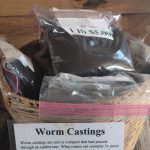 Worm castings are soil or compost that had passed through an earthworm. What comes out contains 5x more nitrogen, 2x more calcium, 7x more phosphorus and potassium and many minerals and beneficial microorganisms all in water-soluble and plant-available forms. Worm “manure” will not burn and is safe for all plants, including houseplants. Worm castings support growth, root development, and disease resistance.
Worm castings are soil or compost that had passed through an earthworm. What comes out contains 5x more nitrogen, 2x more calcium, 7x more phosphorus and potassium and many minerals and beneficial microorganisms all in water-soluble and plant-available forms. Worm “manure” will not burn and is safe for all plants, including houseplants. Worm castings support growth, root development, and disease resistance.
Boulder Dushanbe Teahouse Rose Garden
 Boulder Valley Rose Society
Boulder Valley Rose Society
Hardy Roses Demonstration Garden
1770 13th St. Boulder, Colorado
This garden, planted in 1998, is both the Hardy Rose Demonstration Garden of the Boulder Valley Rose Society and an environment that delights the senses and calms the spirit, such as you might find at a teahouse in Tajikistan.
Designed by Eve Reshetnik-Brawner and Mikl Brawner, the garden includes 43 varieties of roses of many types, including Old Garden roses, Species roses, Canadian, Modern Shrub and David Austin’s English roses. These roses were chosen for their Old World Character, cold hardiness and disease-resistance. In addition, these roses are not grafted, but grown on their “own roots” which makes them tougher and longer-lived. These qualities have allowed the Boulder Valley Rose Society to maintain this rose garden without the use of chemical fertilizers, fungicides and pesticides. These roses are examples of how successful roses can be in Colorado.[Read More]
Dry-Bloom
5-10-5 with 1% Calcium. This increases seed germination, supports transplanting and aids in flower and fruit development. This is also slow release and long lasting. Contains rock dust, meat and bone meal, composted poultry manure, and blood meal.
To Plant to Fertilize
(Just this PDF – should we turn it into a regular page?)

